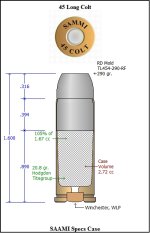Hi:
I have been loading a .451 200 grain JHP bullet with 20 grains of #4227.
Recoil is ok and accurate is very good.
However I have a problem with the bullets in the cases working outwards and binding the cylinder.
The jacketed bullets have no crimping groove and I have tried a tight crimp but the bullets still work out.
Perhaps these bullets are not for a revolver ?
I have been loading a .451 200 grain JHP bullet with 20 grains of #4227.
Recoil is ok and accurate is very good.
However I have a problem with the bullets in the cases working outwards and binding the cylinder.
The jacketed bullets have no crimping groove and I have tried a tight crimp but the bullets still work out.
Perhaps these bullets are not for a revolver ?

